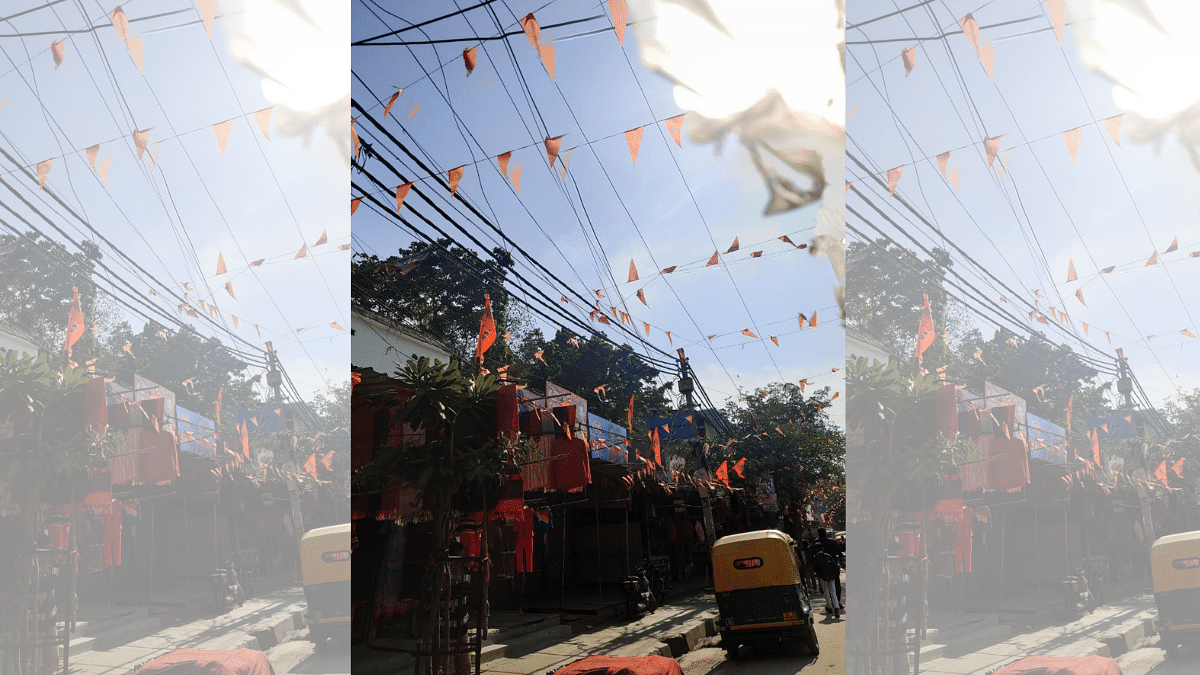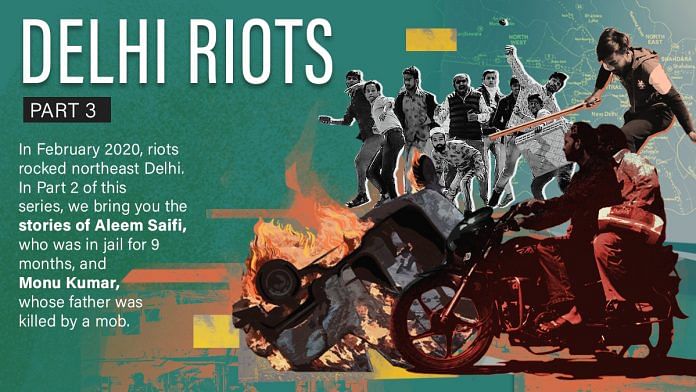New Delhi: Monu Kumar and Aleem Saifi are struggling to move past their ordeals. Their separate faiths notwithstanding, both men saw their world turn upside down in the communal riots which spread like wildfire in northeast Delhi in 2020.
Both men lost family businesses built painstakingly over the years. To add to that, Monu lost his father and Saifi spent nine months behind bars.
The charges against Saifi, who feels he would be still in jail if not for sheer luck, were serious; the prosecution had accused the 35-year-old of carrying a sharp-edged weapon along with being part of a murderous mob screaming ‘Allah ho Akbar’. His mobile location was said to be traced near the spot where Nitin alias Monu Kumar’s father Vinod Kumar was killed in Brahmapuri on day two of the northeast Delhi riots — 24 February, 2020.
Saifi was arrested only after being “identified” by another suspect Arshad alias Sonu in the CCTV footage almost four years ago.
But the prosecution couldn’t produce any “concrete evidence” against him and four others — Naved Khan, Javed Khan, Chand Babu, and Sabir Ali. Further, none of the prosecution witnesses could identify the five as being part of the mob.
On 22 August last year, a Delhi court discharged the five men as the prosecution couldn’t produce concrete evidence even to frame charges against them in the case. Unlike Saifi, the remaining suspects face other charges and are currently out on bail.
The communal riots that began on 23 February and lasted till 25 February left 53 dead, several hundreds injured and resulted in vandalisation of property including places of worship. Nearly 2,600 arrests were made in 757 cases, but the total number of suspects remains unclear as a majority of them were booked in multiple cases.
Rioting and arson, meanwhile, continued to be reported until 29 February.
In the above mentioned case, the court ordered charges to be framed against Arshad alias Sonu, Rais Ahmad, Mohammed Sageer, Mehtab, Gulzar, Mohammed Imran and Amiruddin Malik for rioting, murder, attempt to murder and promoting enmity between religious groups, among others.
Also Read: 4 yrs since Delhi riots — ‘shoddy probe, erroneous charge sheets’, 183 acquittals & 75 discharges
Aleem Saifi: A ‘rare’ suspect
Saifi, a father of two, was granted bail nine months after his arrest in November 2020. In this time, he lost his scissor manufacturing business and the family was forced to rent out their property to a restaurant.
“We lost business after the riots and the pandemic also broke out. I wasn’t here to take care of anything. I spent some Rs 15 lakh in the last three years in the process,” he told ThePrint.
Saifi neither wants to be photographed, nor identified. He doesn’t want anyone to ask him about his time in jail but recollects how the entire process was “torture”.
“The station house officer (SHO) of Jafrabad police station called me one day after the riots, and I went there because I am a local and witnessed the riots. But they arrested me. It hit me like a rock. I was in Tihar jail for a while and was shifted to Mandoli jail. I have blocked the traumatic experiences from my mind; it gives me nightmares,” he said.
Saifi believes that he could manage to walk out free as he was one of the “rare” suspects who were booked only in one case.
As reported by ThePrint in Part-1 of the series on the northeast Delhi riots, data shows that 183 acquittals and 75 discharges have taken place in related cases and most suspects are out on bail. However, a majority of the suspects were booked in multiple cases, which is why they remain accused in some cases despite being acquitted or discharged in others.
“We have clients with 12-13 cases and they have either been discharged or acquitted in 10-11 cases but continue to face the judicial process due to other cases. Investigations into the riot cases have been messy due to which it has affected the judicial process as well,” Shikha Garg, the Delhi Legal Services Authority (DLSA) counsel for the riot accused, told ThePrint.
Saifi claims he doesn’t know any of the other suspects in the Brahmapuri case. “They were all from the other side — from inside the lanes of Brahmapuri. I didn’t know any of them personally till the arrest,” he maintains.
Monu Kumar: A victim of circumstances
On the night of 24 February, 51-year-old Vinod Kumar and his son had stepped out to buy medicines for his ailing grandson. Fearing that a curfew could be imposed anytime, they took the risk in spite of the inkling that a mob was roaming the lanes. Violence had broken out in Brahmapuri earlier in the day and continued from 10 pm till 4 am.
The father-son’s bike with the sticker — ‘Jai Shri Ram’ — caught the eye of the mob. A stone hit Vinod following which both of them lost balance and fell on the road. The mob mercilessly thrashed the duo with rods and sticks; their motorcycle was set ablaze.
When Monu regained consciousness, he tried to carry his father to safety but in vain. A passerby took them to the hospital where Vinod was declared dead on arrival.
Monu runs a DJ business. For nearly four years since the riots, the business had to be winded up and the family survived on savings and compensation. “I have started performing as a DJ at weddings and other occasions from this year. (But) there is a lurking fear of stepping out. My head hurts in the winter due to the injury,” he told ThePrint.
“My father is gone and the matter will go on in the courts for years. We have stopped thinking of the outcome. The entire family has suffered for no fault of ours. My father was beaten to death by a mob in the name of religion and that is something we have to live with for the rest of our lives,” he tells ThePrint.
“I don’t want to set foot in a Muslim house or have any interaction with the community. Things have remained calm since 2020 but who knows?”
Trauma lurking underneath
Four years on, the hustle and bustle has returned to the localities of northeast Delhi.
Hoisted to celebrate the consecration ceremony in Ayodhya, saffron flags flutter in the streets of Gokulpuri and other areas where Hindus form a majority of the residents.

But scratch the surface and the unease lurking underneath is unmissable even after four years. Families lost sons, brothers, fathers and husbands; hundreds were left stranded, without no source of livelihood. The riots left a lasting scar on residents of northeast Delhi.
“We had planned to poison and kill ourselves if the mob would try to break into our homes. Women and children are always the worst affected in communal violence,” recalled a 35-year-old Hindu woman, a resident of Seelampur.
A 40-year-old Muslim woman from Khajoori Khas, adds, “The bloodshed and screams can’t be forgotten. They vandalised our grocery store, and we didn’t know for days because we didn’t step out. The fear that residents lived with for days, can’t be described in words.”
Nearly all families living in areas most affected by the riots — Jafrabad, Welcome Colony, Seelampur, Bhajanpura, Jyoti Nagar, Karawal Nagar, Khajoori Khas, Gokulpuri, Dayalpur and New Usmanpur — have a similar story to tell.
(Edited by Tony Rai)
Also Read: A burnt shop & ‘blunder’: How Akram Malik was charged, then acquitted in a Delhi riots case



